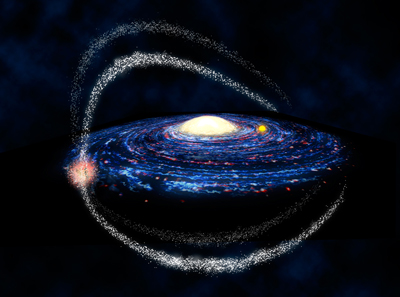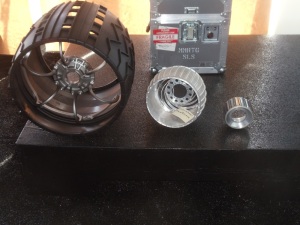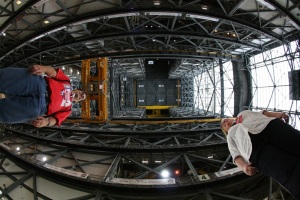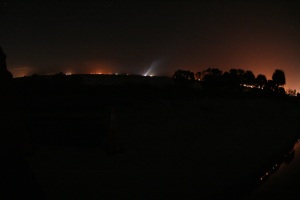 Galactic cannibalism is seen throughout the universe as large galaxies eat up and merge with smaller ones. This process plays an important role in galaxy evolution and is quite common in galaxy clusters.
Galactic cannibalism is seen throughout the universe as large galaxies eat up and merge with smaller ones. This process plays an important role in galaxy evolution and is quite common in galaxy clusters. Our own Milky Way Galaxy participates in the process as well. Recently released findings from the third phase of the Sloan Digital Sky Survey (SDSS-III) have revealed two new streams of stars the Milky Way is ripping from the Sagittarius Dwarf Galaxy, a small companion galaxy of the Milky Way.
Galaxies are not solid objects, but composed of many individual stars and clouds of gas and dust. As the Sagittarius Dwarf Galaxy orbits the much larger Milky Way, some of its stars are closer to us and some are farther away. The ones close to us feel a greater tug of gravity than the ones father away. The difference in gravitational forces starts distorting the galaxy and leads to long trails of stars both in front of the smaller galaxy and behind it in its orbit. The Sagittarius Dwarf Galaxy has probably already lost about half its stars and gas to the Milky Way! Currently, the Sagittarius Dwarf Galaxy is all the way on the opposite side of the galactic center from us so it is very difficult to see.
We knew there were two tidal trails from the Sagittarius Dwarf Galaxy from previously released data. Those tails were near the north galactic cap. Now SDSS-III has released data from the southern galactic cap and Sergey Koposov and Vasily Belokurov of the University of Cambridge analyzed this data to find two new tidal streams. Interestingly, one stream is brighter than the other and appears to be composed of younger stars. Exactly how we got these two different streams with different properties is still a bit of a mystery, but we are getting a lot better at galactic interactions so you can bet people are already working on this one. One idea is that there were originally two dwarf galaxies out there interacting with each other as the Milky Way destroyed them. A collision with a clump of dark matter has also been proposed. Another idea looks at how streams can evolve over time, similar to meteor streams in our solar system.
As this galaxy continues to orbit the Milky Way, it will get ripped apart until there is nothing left but these streams of stars.
Reprinted with permission from the Half-Astrophysicist Blog.
















































